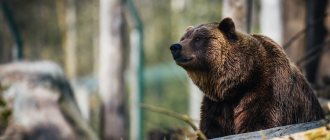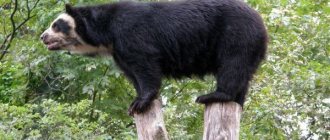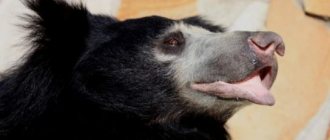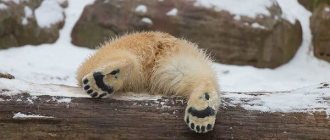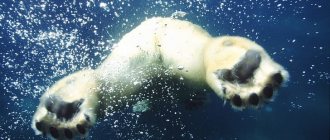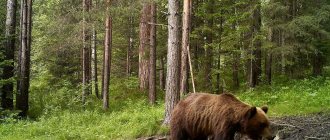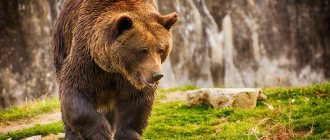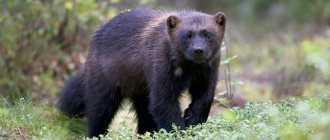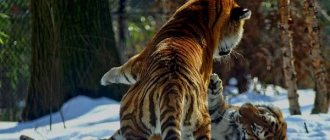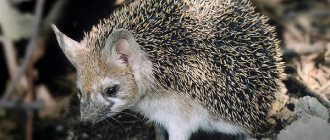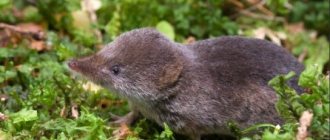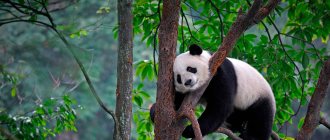Description of the bear
He has a short and thick body, the same neck, and an elongated muzzle. The predator has small eyes and ears. Despite this, he has excellent eyesight and excellent hearing.
The paws have 5 toes with long, very powerful claws. It is not for nothing that they call it clubfoot, because the animal walks by stepping completely on its entire foot. This makes his gait seem clumsy. In fact, without being particularly graceful, bears can move quite quickly. They are very hardy, so they are able to cover long distances without rest.
All bears have a tail. It is usually very short and inconspicuous. Only the giant panda has a large tail.
Animals swim well. The polar bear has webbed feet. Thanks to this, he can stay in the water for a long time, covering distances of 30 km or more without rest.
Moscow region
Status: I category. A species whose numbers have sharply declined and is in danger of extinction.
Spreading
In the territory of the present Moscow region, it lived everywhere until the end of the 18th - beginning of the 19th centuries. Currently, it is celebrated annually in Mozhaisky, Shakhovsky and Taldomsky districts. There is information about meetings in the Klinsky, Dmitrovsky and Sergiev Posad districts. Dens were noted in the west of Mozhaisk and north of Taldom districts, as well as in the Zavidovo State Complex.
Number
The species became very rare already in the 19th century, and in the 1920s. disappeared from its last habitats. Single visits were recorded in the 1950s and in the 1960s. There were no reports of bears. In the 1970s the species again periodically appeared in the north of the Moscow region. Since the 1980–1990s. Against the backdrop of a general increase in numbers in the center of European Russia, the bear again became a permanent inhabitant of the region. It was assumed that in the late 1990s. no more than 10–15 animals lived here. Apparently, this assessment is also valid for the 2000s.
Source: Red Book of the Moscow Region. Rep. ed. T.I. Varlygina, V.A. Zubakin, N.A. Sobolev (2008) Moscow: Scientific Partnership. ed. KMK
Where does a bear live in the wild?
The animal's habitat is wide. It includes the Arctic and Antarctic, Canada and Alaska. In nature, bears can be found in Europe, Asia, and the American continent. Some representatives of predators live in Australia, on the islands of Japan, Sumatra, and Java. They live on plains and mountains, on the shores of oceans, in hot and very cold areas.
Some dig dens, others live in tree hollows, and others live in caves. All bears, except the white one, lead a sedentary lifestyle. They love solitude, although sometimes they can live in families (mother bear and cubs).
Republic of Adygea
Status: II category. Vulnerable species.
Spreading
In Adygea, bears live in the southern, mountainous part, mainly within the boundaries of the KSPBZ, and in the fall they are found in forest areas adjacent to the reserve along the valleys of the Belaya, Kisha, Sakhray, and Kuna rivers. In the near future, the Caucasus Nature Reserve will apparently become the only full-fledged area of the range in the northwestern part of the Caucasus. Intensive development of territories adjacent to the reserve for recreational purposes inevitably leads to a reduction in the natural habitats of bears, and in some places, to their complete displacement. There is a destruction of not only the spatial, but also the ecological and phenotypic structure of the population.
Number
The number of bears in the Caucasus is quite difficult to estimate due to the lack of reliable data. In the northwestern part of the Caucasus, the population size is estimated at 450–500 individuals. In early spring, the number of bears in the mountainous part of Adygea, in the upper reaches of Belaya and Kisha, can reach 100–120 individuals.
Source: Red Book of the Republic of Adygea: rare and endangered objects of flora and fauna. Part 2. Animals. Ed. A.S. Zamotailov, V.I. Shchurov, M.I. Shapovalov, R.A. Mnatsekanov, Kolesnikov S.V., Khunagov R.D., Zamotailov A.S. (2012) LLC “Quality”, Republic of Adygea, Maykop
What does a bear eat?
The animal's diet consists of berries, nuts, and roots. They love fish, insects, frogs and shellfish. The brown bear is not averse to eating the meat of roe deer, deer, and elk. Loves honey. The Malayan bear eats bananas, and the panda eats sugar cane shoots. The smallest marsupial bear, the koala, is a vegetarian: it feasts on eucalyptus, and makes up for the lack of protein by eating soil. This is the only representative whose menu contains neither insects nor the meat of other animals.
How fast does he run?
It is not for nothing that the bear is considered one of the most dangerous predators on the planet. Despite their impressive size and apparent clumsiness, they are able to move silently and run quite quickly in pursuit of their prey. The maximum speed that a brown bear can develop reaches 50 km/h. The grizzly bear is considered the record holder among all representatives of the species: it reaches speeds of up to 60 km/h.
Bear breeding
The bear is a monogamous animal. But despite this, bear families are short-lived. Predators gather together when mating season arrives. After the female is fertilized, the family breaks up. Pregnancy lasts differently for each species. The gestation period for cubs is up to 200 days. Almost all female bears give birth to 1 to 3 cubs. Cubs are born blind, toothless, and without hair. For 2 years they feed on mother's milk. Sexual maturity is reached at 3-4 years. Only after this do they leave their mother.
Vladimir region
Status: I category. A species whose numbers have sharply declined and is in danger of extinction.
Spreading
In the XVIII–XIX centuries. The brown bear inhabited all districts of the Vladimir province, and was most abundant in Murom, Pokrovsky and Sudogodsky. In the 1st half of the twentieth century. The species lived and was caught by hunters in Aleksandrovsky, Vyaznikovsky, Gorokhovetsky, Gus-Khrustalny, Melenkovsky and Petushinsky districts. Since the 1960s noted only irregular visits of bears from the territories of neighboring regions, but over the past 10–20 years, meetings have become more regular. In 2010–2018 Track activity and visual encounters of individual individuals have been recorded for several years in a row in the north of Vyaznikovsky, Gorokhovetsky and Suzdal districts, in Gus-Khrustalny and Kovrovsky districts.
Number
Single visits of migrating individuals are known from most districts of the region. Females with cubs and denning were observed in the north of the Vyaznikovsky district. No more than 4–6 animals are expected to be present in the region at any one time.
Source: Red Book of the Vladimir Region. Ed. R.E. Azbukina et al. (2010) Vladimir: Transit-ICS
Types of bears
Zoologists distinguish several types of bears. Each species has subspecies.
American bear
Baribal, the name of the American bear, is the friendliest of the family. Although, in case of danger, it can hit with its paw, but immediately run away to a safe distance. As club-footed as his relatives.
He lives in 30 US states, from the Atlantic to the Pacific Ocean. It can be found in Mexico and Alaska.
The fur of the baribal is black, sometimes gray or blue-black. The height of an adult male is about 2 m, weight reaches 350 kg. The black bear is the most common species in America.
The American bear eats berries, bees and termites, and fishes. Enjoy the meat of pigs or sheep.
A bear in captivity, under human protection, can live up to 30 years. In natural conditions it lives for 12 years.
The black bear is afraid of people, although it can go out onto the highway or climb into a farm in search of food.
Himalayan bear
The black bear has several names: white-breasted, Himalayan, Ussuri. The most romantic of them: the moon bear. It was given its name because of the crescent-shaped spot on its chest: white, sometimes with a yellowish tint.
The Himalayan bear lives in the forests and hills of Iran and Afghanistan. A large population of the predator lives in the Himalayas, Korea, and Japan. On the territory of Russia - in the Khabarovsk Territory (the image can be seen on the coat of arms), Yakutia. The Himalayan bear is found in Vietnam.
Males are quite large in size: length reaches 1m 80 cm, at the withers - up to 80 cm. Weight - up to 80 kg. Females are much smaller and lighter.
The Himalayan bear is often hunted. At the same time, not only animal fur is valuable. In some countries (Laos, Vietnam, China) it is bred on special farms to collect bile, which is widely used in Chinese medicine. Here the paws of the predator are eaten.
The Himalayan bear spends most of its time in trees. Here he looks for food and escapes from midges. The diet consists of nuts, berries, plant shoots, and acorns. Since the predator's body needs protein, the bear eats ants, other insects, and also frogs.
The Himalayan bear mates from June to August. Females give birth to 1 or 2 babies, weighing 400 g.
Sleeps in winter. The main enemies are the Amur tiger and brown bear.
Life expectancy is no more than 25 years.
Brown bear
One of the largest family of bears, its average size reaches 3 m. It weighs from 350 kg to 450 kg. The heaviest bear lived in the Berlin Zoo, weighing 760 kg. Lives in the Caucasus, in the northern part of Russia. Found in Scandinavia, the Carpathians. A small number live in Palestine, Iran, and northern Iraq. It is difficult to name the exact place where the brown bear lives. The fact is that if there is enough food somewhere, then it will not go further than 500 hectares. If there is not enough food, then the brown bear begins to wander in search of food. The animal is a forest dweller. He prefers to make a den where there are a lot of swamps, in coniferous or mixed forests. It is quite difficult to meet a brown bear, since it is awake at night.
The appearance of an animal is deceiving. He, like the rest of the family, looks awkward: a huge head, short legs, large withers. But it can easily catch up with its prey and swims well (it can swim up to 6 km without stopping). At a young age, it climbs trees very well.
The Predator is endowed with enormous strength. It will not be difficult for him to tear out the ribs or break the skull of any large animal. With a blow from his paw he can break a person's spine. An animal is dangerous after hibernation, when hunger drives it after prey. During this period, he is not averse to eating human flesh.
Sleeps in winter. The longest duration of sleep is about 200 days. The brown bear sleeps for so long on the Kola Peninsula, where winter lasts from November to April and longer. The animal prepares its den in advance: it finds a dry place, covers it with dry leaves, hay, and branches. Very rarely it can build a rookery directly on the ground.
Pregnant bears arrange their dens in such a way that there is plenty of space and ventilation. In winter, the den is covered with snow, which becomes a kind of blanket for the mother and cubs.
The animal sleeps very lightly. This dream is like numbness. He wakes up when he runs out of fat reserves.
Animals that for some reason have not gained fat do not hibernate at all, but wander through the forest, looking for food. They are called "connecting rods". These predators are the most dangerous.
Animals kept in nature reserves do not become kind and affectionate. There are cases when they attacked and maimed people who did not follow safety rules, or tried to feed or pet predators.
Life expectancy is about 30 years, in a seine - up to 50 years.
Malayan bear
The local population nicknamed the animal the bear-dog. The maximum length of the body barely reaches 1 m 50 cm, weighing from 25 kg to 65 kg. The yellow spot on the chest looks like the rising sun, so another name is sun bear. It is assumed that the black bear uses the light spot to intimidate enemies. During the fight, he takes a threatening pose, standing upright on his hind legs. A distinctive feature is loose skin around the neck. This allows the animal to turn its head and deliver unexpected blows with its fangs. Leopards and tigers are dangerous for biruang.
The black bear lives on the island of Java, Sumatra, on the Malay Peninsula, Borneo. Habitat: tropical, subtropical forest, sometimes found in the mountains.
The sun bear is the most aggressive of the family. With sharp fangs, he chews wood to get insects out of it. In addition, it feeds on berries and earthworms. It is not carnivorous, but can eat lizards and birds. He enjoys eating bananas and coconut palm sprouts. Zoo workers know what the animal eats, but they give them peanut butter and crickets to eat.
It is not known exactly how long a black bear lives in natural conditions. In captivity, its age reaches 24 years.
The sun bear is monogamous. There is no specific period for mating; it can occur at any time of the year. Mating games last from 2 to 7 days. The female's gestation period can last from 95 to 210 days. Brings from 1 to 3 cubs, which are born blind; the weight of newborn puppies is about 300g. They grow very quickly. 2-3 months after birth, they run, play, and eat with their mother, although they suck milk until 4 months.
The animal is listed in the Red Book as an endangered species.
Grizzly
The gray bear lives in Alaska and northern Canada. A small number survives in Montana, near Washington and Yellowstone. The bear's height is about 4 m, its claws are a dangerous weapon 15 cm long. There is no exact answer to how much a grizzly bear weighs. The maximum weight is about 210 kg, the smallest female weighs just over 130 kg. Like the brown bear, it can live up to 30 years. Grizzlies are considered a bloodthirsty predator, although the food that the animal eats is no different from the diet of its relatives. The gray bear prefers algae, shoots of young plants, and berries. He loves fish, honey, and does not neglect frogs and lizards. He can smell the smell of carrion 30 km away and eats it with pleasure. Hunts mainly for weak or young animals. Capable of reaching speeds of up to 60 km/h, swimming across a river with ease, while demonstrating his enormous strength. A grizzly bear fishes during the salmon spawning season. It lowers its head into the water and catches prey with its teeth or paw. Particularly dexterous animals are able to catch fish when they jump out of the water.
A grizzly bear spends the winter in a den. During the thaw, he wakes up and wanders through the forest, looking for food. Goes to bed again when the frost gets worse.
Being solitary animals, they communicate only during the mating season. From the moment of mating to the birth of the cubs, about 250 days pass. Their mother takes care of them for 2 years.
The grizzly bear does not pose a threat to humans. He can show aggression towards him only when he senses danger.
Polar bear
The king of the Far North and the Arctic Ocean is the polar bear. The largest representative of the family. Height 1.5 m, length 3 m. The male is much heavier than the female. It weighs 450 kg, the maximum weight of a female is 250 kg. Habitat: Far North. It is found on the island of Spitsbergen, on Novaya Zemlya, in the Hudson Bay area. Sometimes, drifting on an ice floe, he ends up in Iceland.
The bear's body is elongated, thick, with a large layer of subcutaneous fat. The predator's feet are longer than those of its relatives, since it needs to walk on snow. The feet are webbed for swimming. The coat is white or with a yellowish tint, regardless of the time of year.
Although clumsy in appearance, the northern bear is an excellent swimmer. The speed it reaches is 45 km/h. Even in Arctic waters it can swim 80 km without a break. The undercoat serves as an air cushion for it. Has no equal in catching fish.
The polar bear has sharp eyesight and is well oriented in the vast expanses of snow. He easily determines the road he needs, and at the same time chooses the shortest distance to get to the goal he needs.
The polar bear is the largest animal in its range, so it is not afraid of anyone. A wonderful hunter. It eats everything that lives around, but a special delicacy is the eggs and chicks of Arctic birds.
For an animal, frost of 80˚C does not pose a problem. The main thing is that there is water nearby, not covered with ice.
The female hunts all year round, leaving this activity only during pregnancy. During this period, she hides in a hole made of snow, bearing cubs, supporting the body with accumulated subcutaneous fat. Usually she gives birth to 2 babies, whom she quickly teaches all the intricacies of northern life.
Today, hunting the animal is prohibited. Killing them is allowed only for the purpose of self-defense.
The life expectancy of the animal reaches 25 - 30 years.
A polar bear never attacks a person. This can happen if the animal feels aggression from him. A predator can approach a person only out of curiosity. But if a person begins to feed the bear, then he will begin to perceive it as a source of food.
Gubach
The length of the predator reaches 2 m, the height at the withers is from 60 cm to 90 cm. Females are about a third smaller than males. The animal has a massive body with a large head and an elongated muzzle. His lips are always protruded forward, completely devoid of fur. The coat is often black, sometimes with a dirty brown tint.
You can meet a bear in India, Pakistan, and Bangladesh.
Panda
The bamboo bear, which previously had other names: cat bear, spotted bear, lives in the northern regions of China. At the beginning of the 20th century, it became the emblem of the country. Males are 10% larger than females and 20% heavier. The length reaches 1.8 m, weight – up to 160 kg. A panda is a bear with a special coat color: the main color is white, the paws, ears, and round spots around the eyes are black. The panda has a tail 10-15 cm long. The front paws have five toes and a sixth one, designed for tearing apart the thinnest bamboo stems. This plant is the main food of the animal, the daily norm is about 30 kg. Pandas, like all bears, need protein. To replenish it, they eat eggs, insects, and sometimes small animals.
The spotted bear's habitat is wide; in summer it climbs to a height of up to 4000 m to escape the heat.
The sexual maturity of the animal occurs from 4 to 8 years. Pregnancy lasts from 3 to 5.5 months. Usually 1 or 2 cubs are born, weighing up to 130 g. In this case, the mother takes care of the first baby, abandoning the second. Childbirth occurs once every 2 years. Therefore, the population is growing slowly. Life expectancy is 20 years.
The panda is considered an endangered species. According to the latest data, the number of animals is just over 2 thousand.
The Chinese authorities have taken the animal under state protection. The death penalty is provided for its destruction.
Koala
The animal's homeland is Australia. The answer to the question of which family it belongs to is controversial. The koala is both a marsupial mammal and a marsupial bear. Perhaps the only similarity with the appearance is external. Soft gray fur, small eyes, downturned nose, round ears leave no one indifferent.
The animal's height is only 60 cm, weighs from 4 kg to 13 kg. The limbs and claws of the beast are designed in such a way that it can climb trees.
The papillary pattern of the finger pads is so similar to that of a human that it is difficult to distinguish them even with a microscope.
The koala's diet consists of eucalyptus leaves and bark. A plant that is poisonous to others is not dangerous to the koala. Every day they eat from 500 g to 1 kg of the plant. To replenish microelements, they eat soil.
The marsupial bear is a slow animal, motionless for almost 20 hours a day. At this time, he chews leaves collected and stored behind his cheeks, or sleeps, or slowly moves along the tree trunk. The animal swims beautifully. He can jump, but he does it to escape danger or in search of food.
From October to February, koalas breed. Several females gather near one male. Pregnancy lasts a little over a month. The newborn stays in the mother's pouch for six months, where he feeds on her milk. For the next six months it lives on its mother’s fur, tenaciously holding on to it.
Animals are like children: they are easily tamed by humans. They love to be petted. Left alone, they begin to feel sad and cry.
The koala has no enemies, because the bear cub smells of eucalyptus. It is destroyed by drought, lack of food and poachers.
Koalas do not live long, only 18 years.
Nature took care of preserving the species by giving males two penises, and females two vaginas.
Bryansk region
Status: I category. Endangered species.
Spreading
The southern border of the species' range passes through the Bryansk region. At the beginning of the 20th century, the bear was common in the northwestern and eastern regions; in the central and southern regions - rare. Since the late 1950s. An isolated and small population has formed in the region, cut off from the main range. Over the past 30 years, the bear has been recorded in 20 areas. The bulk of the population lives in the forests along the left bank of the Desna.
Number
In the 1930s the number was estimated at 60–65 individuals; by the end of the 1940s. - 46 individuals. In 1958, a ban on hunting animals was introduced in the region. Despite this, the species' numbers continued to decline. In the 1970s there were 30–40 individuals, 1980s. – no more than 10 individuals. To preserve the bear population from 1996 to 2014. 16 cubs were introduced into the reserve. As of 2015, the number of bears in the region is estimated at 45–50 individuals, of which 20–25 individuals live on the left bank of the Desna River.
Source: Red Book of the Bryansk Region. Ed. HELL. Bulokhov, N.N. Panasenko, Yu.A. Semenishchenkov, E.F. Sitnikova (2016) Bryansk: RIO BSU
Chuvash Republic
Status: II category. Vulnerable species.
Spreading
In Chuvashia, it is observed in the Trans-Volga region, the Sur region, the Pre-Volga region, and the South-East (isolated cases). In the Trans-Volga region, during the snowless period, individuals coming from the Republic of Mari El are regularly recorded. Sometimes in the summer-autumn season, bears and traces of their activity are observed in the vicinity of Cheboksary, Marposadsky, Kozlovsky districts. Apparently, these are entries from the Mari El Republic through the Kuibyshev and Cheboksary reservoirs.
Number
Rare. There is no reliable information about the number. No censuses have been carried out in recent decades. According to survey information from the state hunting supervision service, in the 80s of the last century there were about 10 individuals, in 2007 - 20-25. The population growth is very slow.
Source: Red Book of the Chuvash Republic. Volume 1. Part 2. Rare and endangered species of animals. Ed. Isaev I.V., Dmitriev A.V. (2010) Cheboksary: State Unitary Enterprise IPK Chuvashia
Ryazan Oblast
Status: I category. A species whose numbers have sharply declined and is in danger of extinction.
Spreading
Since the beginning of the 20th century. until the 1960s At least 20 individuals constantly lived in the Ryazan region, including 3-4 annually recorded in the Oksky Nature Reserve. In 1970, only one animal was constantly recorded in the region, and one individual entered the Kasimovsky district from the Nizhny Novgorod region. In 1980, bears permanently living in the region were not counted. In the last two decades of the 20th century. individual non-breeding animals came from the Nizhny Novgorod region and Mordovia. In the 1990s. noted in Kadomsky district. In OGPBZ from 1970 to 1997. bears were not recorded, but since 1998, encounters have become regular. In 2001, near the lake. Velskoe was noted to be located in a den. In June 2003, in the Chaslovsky hunting area (north of the OGPBZ), a bear cub was taken from a dead (probably shot) female bear, which was kept in an enclosure for some time. In August 2007, a mother bear and her cub were seen in the Central Forest. In 2009, a brown bear was definitely registered only in the Ermishinsky district (6 sightings, 3 of them visually); in the Kasimovsky and Klepikovsky districts, only visits along the tracks were noted.
Number
Additional research is required on the issue of habitat in the region.
Source: Red Book of the Ryazan Region. Ed. Ivanchev V.P., Kazakova M.V. (2011) Ryazan: NP “Voice of the Province”
Ulyanovsk region
Status: I category. A subspecies whose numbers are rapidly declining. Endangered.
Spreading
In the territory of the Simbirsk province - Ulyanovsk region, it practically disappeared as a result of the clearing of dense forests and hunting at the beginning of the 20th century. Even at the end of the 19th century, bears were found in the western regions of the Right Bank, especially in the forests of the Surye region. Currently (at least since 1973, almost constantly in 1984-2003) the bear lives in the Sursky and Inzensky regions. Individual encounters were registered in the Ulyanovsk region in the Undorovsky mountains on the border with Tatarstan in the 1960s and in the Karsun region in the 1980s.
Number
1-3 individuals are found in the Sursky Zoological Reserve and its surroundings.
Source: Red Book of the Ulyanovsk Region. Ed. E.L. Artemyeva, A.V. Maslennkova, M.V. Korepova (2015) Moscow: Buki Vedi Publishing House
Habitat
They were able to survive in greater numbers only in the USA, Canada and Siberia. These are sparsely populated places where they have enough space.
Chechen Republic
Status: II category. A species with declining numbers and range, vulnerable to anthropogenic impacts.
Spreading
According to our data, it lives, as a rule, in a narrow zone from 1000 m above sea level. and up to 3000-3200 m. Within the Czech Republic, the brown bear is found from the borders of the forest zone to alpine meadows. Traces and adult individuals were repeatedly encountered in the upper reaches of the river. Sharo-Argun, Chanty-Argun. Recorded in the vicinity of Shatoy, Vedeno, Kharachoy.
Number
The number of brown bears in the territory was previously low. In the post-war years, no more than 70 individuals lived in the Grozny region, which was due to the conditions of the war period. By the 70s of the last century, the number increased to 120 heads, and then, by the 90s, to 150-200 heads.
Source: Red Book of the Chechen Republic. Rare and endangered species of plants and animals. Ed. Taisumov M.A., Teymurov A.A., Umarov R.M., Terekbaev A.A., Abdurakhmanov G.M. (2007) Grozny: Southern Publishing House
Tambov Region
Status: 0 category. Probably an extinct species.
Spreading
On the territory of the present Tambov region at the end of the 19th - beginning of the 20th centuries. The species lived in the Tsninsky forest. The southern border of the range ran just south of Tambov. Subsequently, it began to shift to the north. According to our data, some of the last meetings occurred in July 1967 and September 1969 in the lower reaches of the river. Kersha, in the vicinity the former village of Shaypok and the former cordon Koroviy Brod, respectively (Morshansky district). Based on survey information, the bear was recorded in the northern regions of the region until 1975. The presence of the species in the forests of the Zemetchinsky district of the Penza region, very close to the border of the Tambov region, gives reason to assume the possibility of individuals of the species entering our region.
Number
At the end of the 19th century. was not a very rare species. For example, in the winter of 1895, 4 individuals were encountered only in the Tambov district. By 1920, it became much less common in the forests of Tambov district. Bears were observed somewhat more often in Morshansky district. In the 1970s, apparently, it was completely exterminated in the region.
Source: Red Book of the Tambov Region: Animals. Ed. HE. Artaev, E.A. Ganzha, V.V. Glushkov, A.N. Gudina, A.V. Emelyanov, Yu.V. Zakharov, R.N. Ishin, E.V. Kalinkina (2012) Tambov: Yulis Publishing House LLC
Altai Republic
Status: II category. Rare, declining, isolated population.
Spreading
According to early reports from researchers working in Altai, the range of this population included the northern outskirts of the Chui steppe with the foothills of the Kurai ridge, in the east it reached the Chikhachev ridge and the Talduair massif, in the west the bears were found on the Ukok plateau. Then the animals of this population could come into contact with the usual form of the brown bear, and panmixia could take place. Currently, there is a significant reduction in the range, as a result of which the small remaining population is isolated from other habitats of brown bears in Altai.
Number
At the end of the 80s. last century, the number of bears in the Sailyugem group, according to observations and survey data, was 70–90 individuals. A few decades earlier, the stock of these bears amounted to several hundred individuals. Currently, the population size on the Saylyugem ridge and the eastern spurs of the North Chuya ridge does not exceed 30–40 individuals. There are no current data on the South Chuya Range.
Source: Red Book of the Altai Republic. Animals. Ed. A.V. Bondarenko (2017) Gorno-Altaisk
Tula region
Status: 0th category. A species that has not reproduced in the territory under consideration for more than fifty years.
Spreading
Brown bear, common in the 17th-19th centuries. throughout the territory of the modern Tula region, by the end of the 19th century. was completely exterminated here. However, for a long time there have been reports of the species entering the forests of the Belevsky and Suvorovsky districts from the territory of the Kaluga region. A number of information about these meetings is given by the Belevsky local historian: in 1958, one specimen was caught by a hunter, which residents of the village of Pashkovo still remember; In the spring of 1996, during a walk around the Belevsky forestry, a forester discovered an empty den where a female bear had spent the winter and her tracks. According to the stories of residents of dd. Gryazny and Utkino, bears were seen here for two more years in a row. A bear was observed in August 2006 in the forest tract Kosovets.
Number
The number is unknown.
Source: Red Book of the Tula Region: animals. (2013) Voronezh: Quarta
